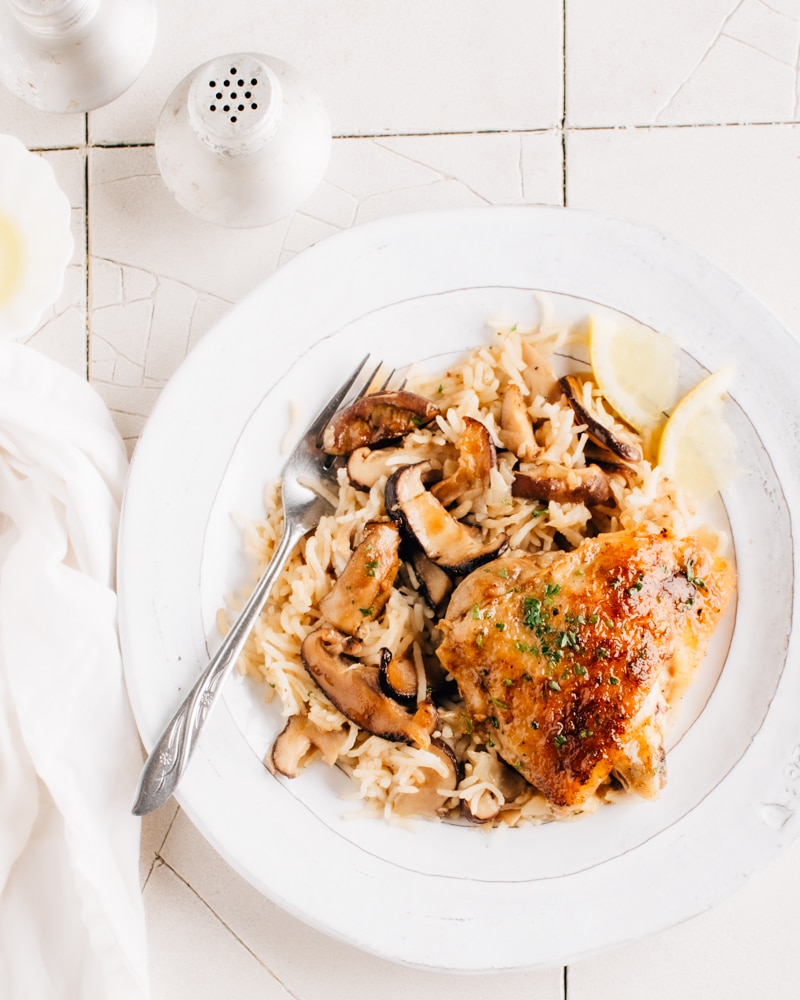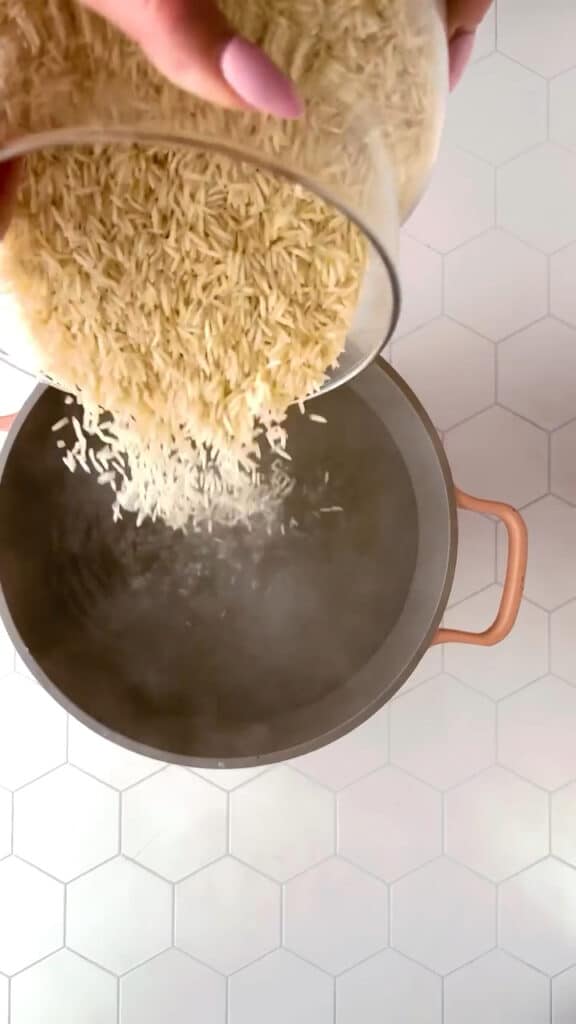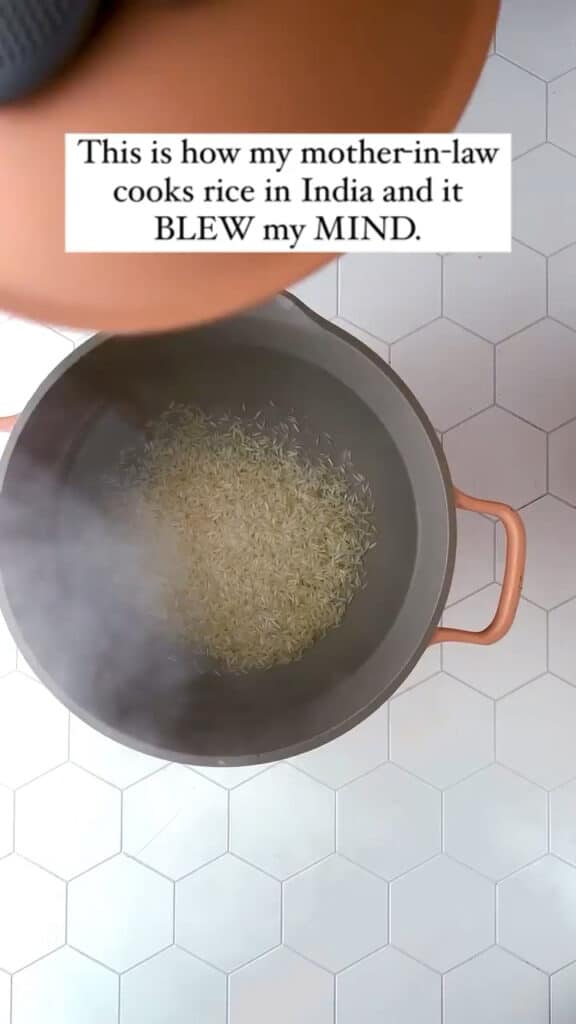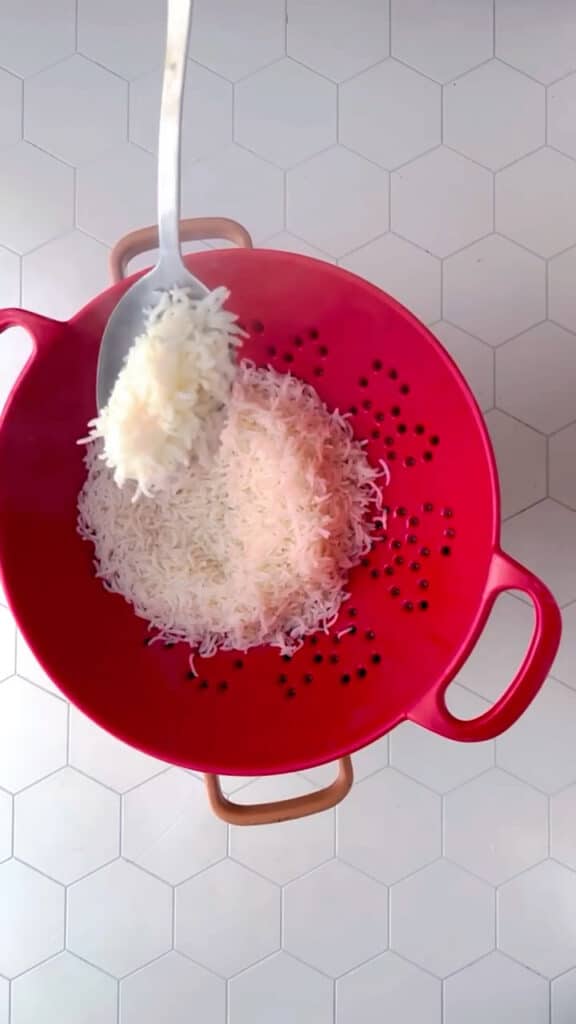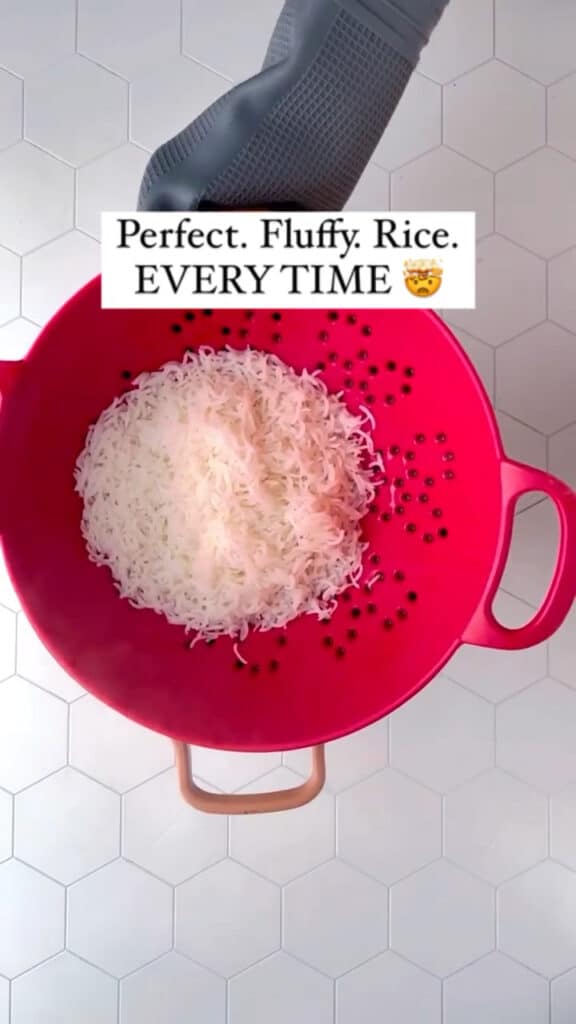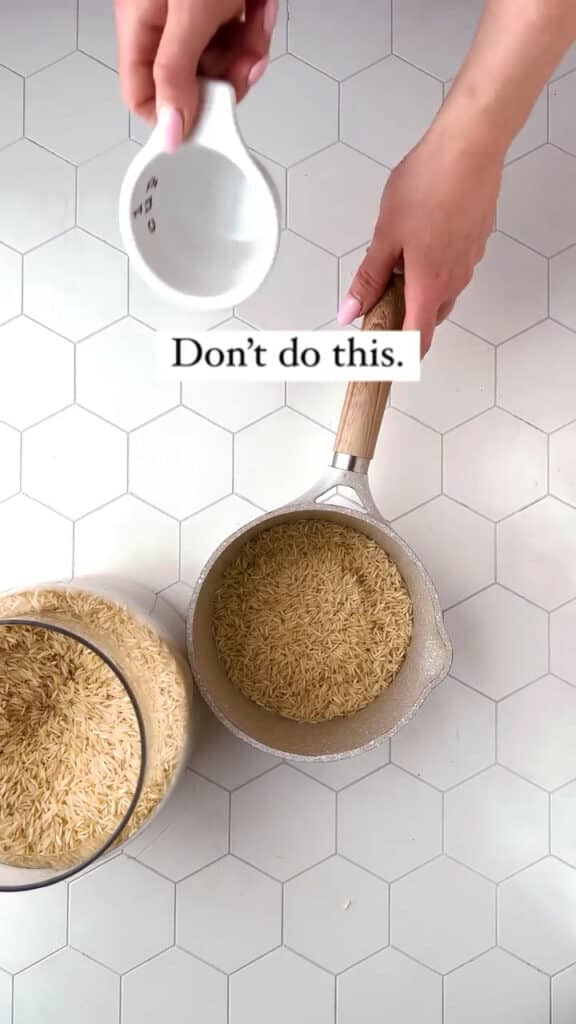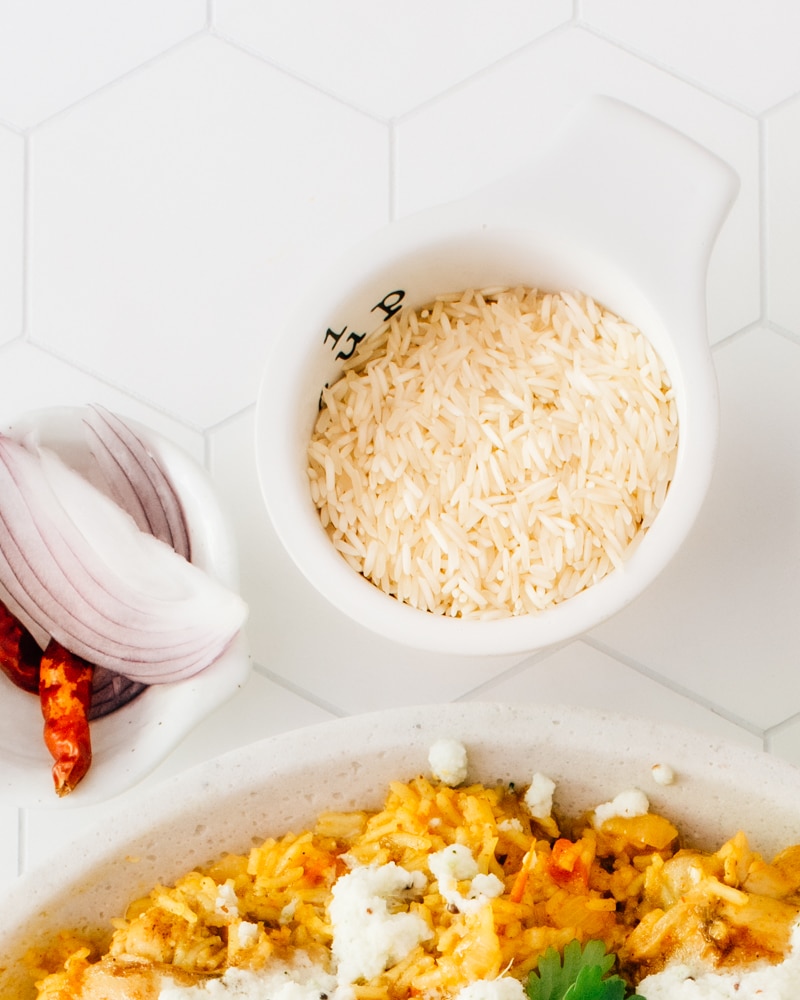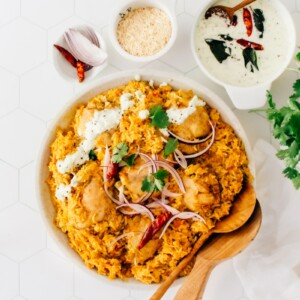Feb 02, 2024, Updated Nov 03, 2024 No more awkward measuring and nervous waiting to see if your rice comes out alright; let’s go!
Why You’ll Love This Easy Basmati Rice Recipe
Can we take a moment to acknowledge that we have been complicating the process of cooking basmati rice until now? Ok, great, let’s move on together. Here’s why this is the only way I cook basmati rice now:
No more measuring! What else is there to say – it’s just an unnecessary step. You’ll get fluffy, separated grains every time – it’s a failproof hack. I cook any and all grains this way.
Here’s What You Need For Cooking Basmati Rice The Easy Way
Gather these ingredients and tools to make a pot of basmati rice with the perfect fluff!
Ingredients for my perfect basmati rice recipe
Basmati rice: This will work for any basmati rice grain variety – short or long grain rice, brown or white rice will all do. Salt: I like to season my cooking water with Kosher salt, but any salt will work. You can dial the amount of seasoning up or down as you like. Water: You can either boil your water in a kettle and add it to your pot or just heat it straight in your medium-large pot.
Variations and Substitutions
As mentioned earlier, you can substitute rice with any other grain and cook it in the same way. Quinoa, barley, and amaranth all work well when cooked this way.
Grab these tools
While we are in the mode of time-saving, gather up these two tools:
Pot: I recommend using a large pasta pot or just one of your bigger pots with a lid. Colander: This is used to drain the water from the cooked rice before adding it to its serving bowl or platter. You could also use a fine mesh strainer, but the grains can sometimes get stuck in the mesh.
Ok, with everything ready, you’re set to make the best basmati rice recipe!
How to Make The Easiest Basmati Recipe: A Failproof Guide
Here is how to make the most delicious basmati recipe without breaking a sweat. You’ll never make it any other way after this.
How to Cook the Basmati Rice
Rinse your rice well under cold running water. Bring a pot of water to a low boil (just above a simmer) Add the salt, just like you would when seasoning water for pasta. Cook the basmati, with the lid on, at a low boil until soft and tender. Strain the rice through the colander. Loosen your rice with a fork if necessary.
A Few Notes:
The length of cooking time depends on the rice grain/variety. Start testing the doneness of the rice at around the 5-minute mark. You want to test it a little sooner than the packaging instructions recommend. For something to work with, my white basmati takes around 15 minutes. The amount of salt varies according to how seasoned you like your rice. As a guide, add 2 tsp Kosher salt per liter/quart of water. Use half this amount if you prefer gently seasoned grains. Wondering how much rice you need to cook? See my guide to how much rice per person.
Make Ahead and Storage
Here’s how to cut the time further and make your leftovers last longer:
Parboil: You can choose to parboil the soaked rice. Boil it for 5-7 minutes, drain, and let it cool. Cool completely: Allow the cooked Basmati rice to cool completely before storing. This prevents condensation inside the storage container, which can make the rice mushy. Portion control: Divide the rice into smaller portions in airtight containers, before storing. This makes it easier to reheat only the amount needed. Refrigeration: For short-term storage (up to 3 days), keep the rice in the refrigerator. Make sure the refrigerator temperature is set below 40°F (4°C) to prevent bacterial growth. Freezing: For longer storage, you can freeze Basmati rice. Allow it to cool, place it in freezer-safe bags or containers, removing as much air as possible, and store it for up to 3 months. Reheat from frozen when needed.
How to Serve this Easy Basmati Rice Recipe
This basmati rice is the perfect simple side to many of my favorite dishes. Here are a handful of options to try:
Basmati Rice is a Great Side For:
Honey Garlic Spare Ribs: Melt in the mouth pork spareribs basted in a Chinese-style sticky honey garlic sauce. These flavors beg for a humble side of rice. Chicken and Broccoli: Umami-laden, light and healthy. This is a great partner to fluffy rice. Easy Malai Kofta: This recipe has a super rice gravy/sauce that pairs perfectly with my easy basmati rice recipe. Chicken Korma: This is another deeply comforting (aka rich and creamy) curry you HAVE to try with a helping of rice. It’s just as delicious with butter chicken!
4 Common Mistakes When Making Basmati Rice
Here are the most frequent mix-ups to avoid when making basmati rice:
Overcooking the Rice: This leads to mushy, soggy grains. Keep an eye on your rice, and remember to test the doneness early. Not Rinsing the Rice: Skipping the step of rinsing the rice can lead to excess starch on the grains, resulting in a sticky or gummy texture. Under or Over-seasoning: You’ll need to season according to your taste. Under-seasoned rice, in my opinion, can let the meal down. Storing it warm: Sealing hot or warm rice will result it mushy grains as the rice will steam inside their container.
Final Notes, Pro Tips + Science-Based Secrets
Unlock the full potential of your fluffy basmati rice with these key takeaways:
Cook in a large pot: Just like you would with pasta or potatoes. Cook in plenty of already boiling water: Season the water well so your rice isn’t bland. Test early for doneness: Start checking your rice grains from about 5 minutes into cooking them. Cool the rice before storing: This will help retain that lovely fluffy texture.
Just skimming through? Here are some quick answers to the commonly asked questions. Can I use any type of basmati rice in this recipe? Yes, you can. This recipe works for any basmati grain variety, including brown basmati rice. Keep in mind the cooking time may vary. Can I use this method of cooking basmati rice for other types of grains? Absolutely! This method of cooking basmati rice is also the perfect way to cook quinoa, millet, amaranth etc. What is the best way to store cooked basmati rice? Store cooked basmati rice in an airtight container (completely cooled) in the fridge for up to 3 days or in the freezer for up to 3 months. Do I need to rinse basmati rice before cooking it? Yes, I recommend rinsing it in cold running water so that it is clean and free from excess starch. How long does it take basmati rice to cook in boiling water? The cooking time for basmati rice, when boiling it, depends on the variety and quantity of the rice. Start checking doneness after 5 minutes to be safe. Do I need to measure the water? No, you don’t need to measure the rice and the water. Just make sure you have plenty of water versus the amount of rice you want to cook. Should I stir the rice while its cooking: You can stir the rice once or twice while it’s cooking but not more than that or the texture will be affected. How can I prevent the rice from sticking to the bottom of the pot? To prevent the rice from sticking to the base of the pot, have a high ratio of water to rice and cook it on a low boil. Can I add extra spices and flavorings to the rice? Absolutely! Add ground or whole spices, seasonings and flavorings to your rice as you like. Basmati rice is gorgeous, with turmeric, cinnamon, cardamom, or cloves added to the water.
Other Favorite Indian Family Recipes
Put some of Adarsh’s favs on your must-make list:
The Chicken Korma that he says will change your life. Best-Ever Creamy Butter Chicken (one of the most popular recipes on the website!) Easy Homemade Butter Paneer (the vegetarian version) Palak Paneer (the tastiest way to eat a pound of spinach) or Saag Paneer The Butter Naan Recipe that nearly broke the internet Creamy Madras Lentils Amma’s special Masoor Dal and Indian Chickpea Curry Recipe Malai Kofta (paneer and potato balls in creamy tomato sauce). It’s my favorite dish to order in an Indian restaurant and even better homemade! Indian Chai (tea the authentic Indian way) Paratha (flaky, layered Indian flatbread)
